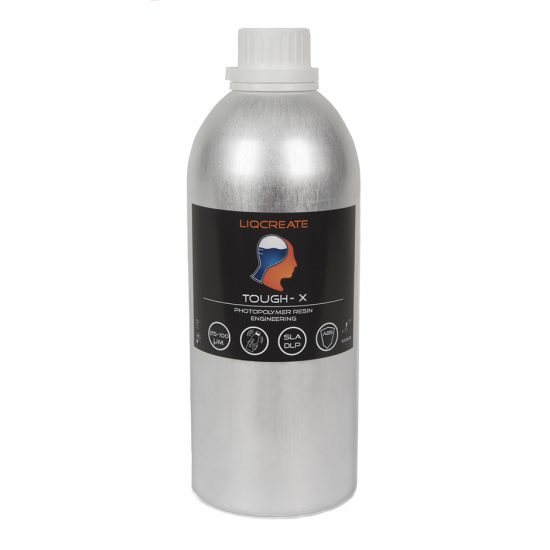Liqcreate Tough-X is a durable opaque black photopolymer resin with high impact resistance. 3D-printed parts from this material have exceptional impact strength. Liqcreate Tough-X can be 3D-pinted on open DLP and MSLA 3D-printers in the range of 385 – 420nm and only requires UV post-curing. Thin parts of Tough-X have rigid rubber-like properties while thicker designs feel robust like ABS plastic. This material has excellent properties like high impact strength and up to 150% elongation, making it perfect for the production of Industrial spare parts and other functional products. If you have any questions, reach out to us at info@liqcreate.com and our technical team will assist.
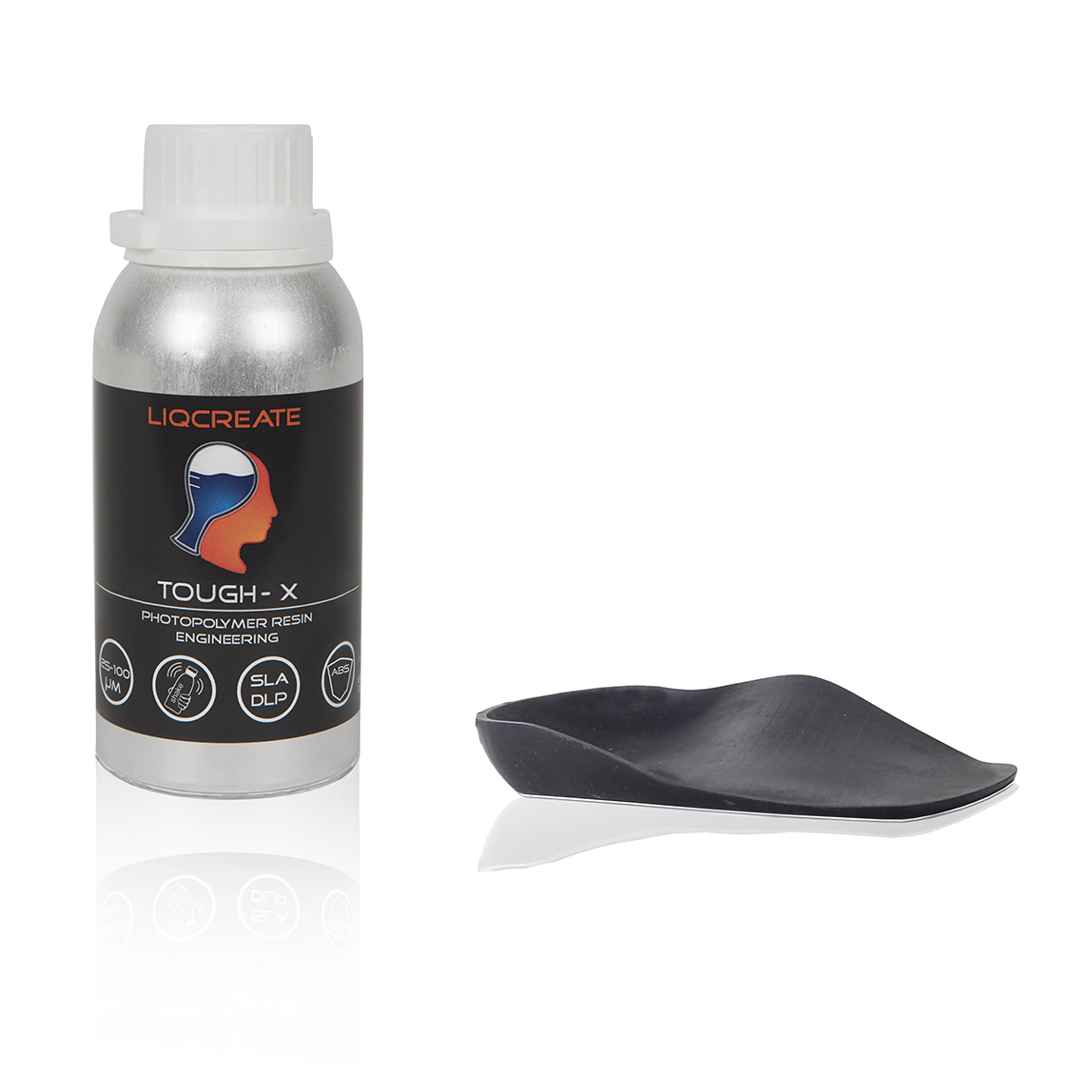
The following topics are covered in this article:
- Shake before use & stir before print.
- 3D-printing parameters.
- Support settings.
- Cleaning, washing and post-curing your part.
- Part is not rigid enough.
- How to clean/filter the resin?
- Minimum wall thickness.
- Part orientation and over-hang.
- Part surface finish or sticky surface.
- Swelling of (green) printed parts during washing
- Shrinkage compensation.
- Resin printing temperature.
- Solving print failures.
- Storage conditions.
- Additional documentation.
Support
Do you need any help with 3D printing our SLA, DLP or LCD resins? We can help you! Just look for the question you have below. If you can’t find it, let us know by contacting us!
Printer Settings →
1) Shake before use & stir before print.
For most resin, shaking for a couple minutes is advised, especially after longer storage to get a homogeneous mixture before printing. Same goes for Liqcreate Tough-X. Shake for a couple minutes and let the resin rest for a couple minutes before using. During shaking the resin is homogenized, but some air bubbles will be present. If you start a print job right after shaking, air bubbles might be present in the first layers of the part.
2) 3D-printing parameters.
Liqcreate Tough-X 3D-printing resin is designed for open compatibility on 405nm and 385nm DLP, MSLA, LCD and laser-based resin 3D-printers. It is important that the 3D-printer is open for 3rd party resins and parameters can be changed. A lot of parameters are already prepared and listed here. Click on your actual printer to see if Liqcreate Tough-X parameters are available. If that is not the case, send an e-mail to our technical team at info@liqcreate.com and they will try to help.
3) Support settings.
Support settings are depending on the type of resin in combination with the type of printer, release mechanism, material on the bottom of the resin tank and also the secondary settings like print speed. With the extreme growth of available resin 3D-printers in the past years, it is impossible to give validated support settings for each printer. In this section you can find settings for some generic printers, design and print speed. We tested a standard design with different settings. If your part is more bulky / large cross-section for each layer, then the support tip thickness or intersection might need to be increased.
It is recommended to print without raft settings as Tough-X has a strong adhesion to most build-plates. Printing without raft like the settings below will make it easier to remove parts from the build plate.
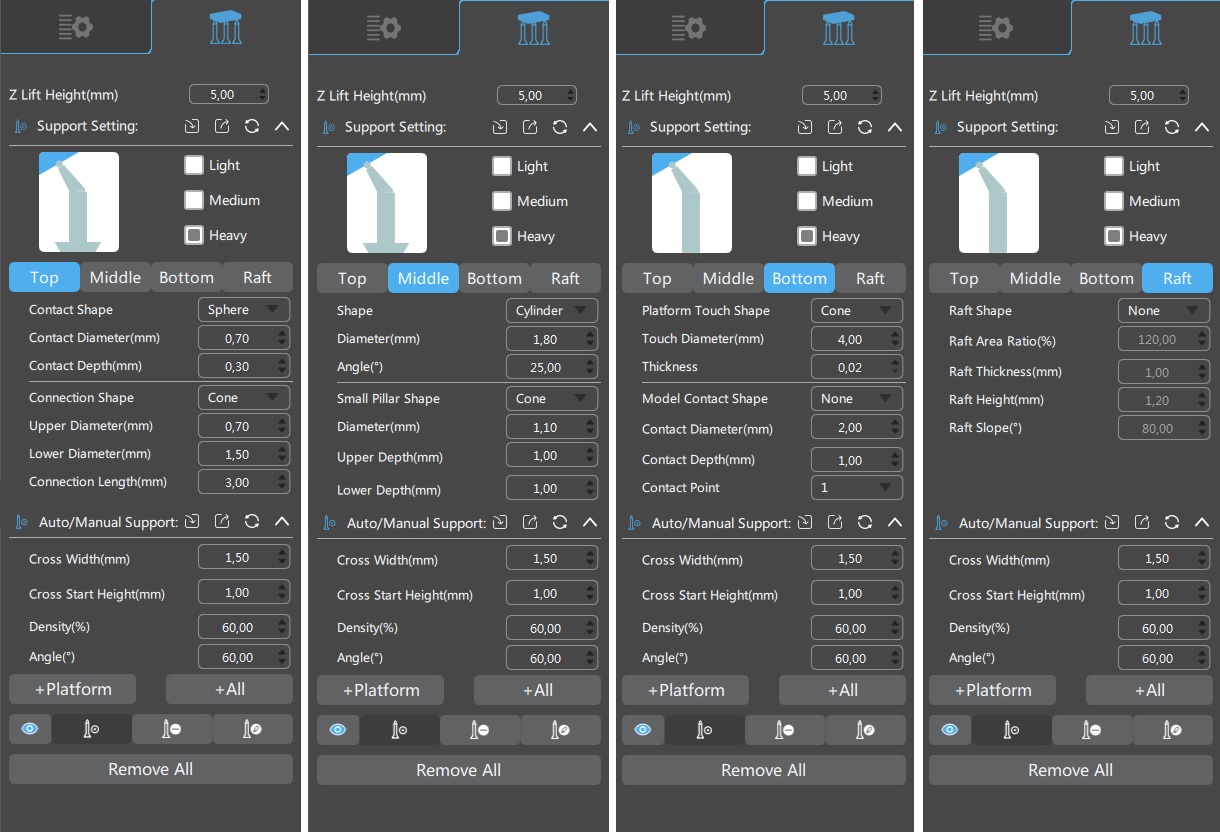
Image: support settings of Tough-X with our generic test parts.
4) Cleaning, washing and post-curing your part.
It is advised to wash in either IPA, Ethanol or Liqcreate resin cleaner. For resin cleaner the cleaning instructions on that webpage can be used. For IPA and Ethanol they can be used in an ultrasonic cleaner or cleaning unit with agitation (like the new low costs Anycubic / Elegoo washing unit). Preferably 2 times 2 minutes washing of which the second time in fresh IPA / ethanol. If there are small cavities that are not cleaned by this method, then use a soft brush to clean them out and wash in fresh solvent again for 1 minute. Then let the part dry on your desk for 2 hours. Tough-X will absorb some ethanol / IPA. By resting for 2 hours after washing the part will go back to its original shape and properties. Before post-curing, inspect that the part is dry and completely free from solvent (no shiny resin spots on the surface). Otherwise wash again in fresh solvent for 1 minute (and wait 2 hours again). Do not wash for longer than necessary as parts can deform when exposed to IPA / Ethanol for >10 minutes when not fully cured. Also be careful if your parts are thin (<2mm) and the IPA in the ultrasonic cleaner is warm (>30°C / 86°F), parts can warp. If you notice this, either make the parts thicker or wait until the temperature of the IPA is below 30°C / 86°F.
When small holes and tight corners are difficult to clean, then brushing with a soft brush is advised to clean these specific areas. After brushing, rinse in fresh IPA / ethanol to get all resin leftovers cleaned.
If you have a heated curing unit, then cure for 30 minutes at 60°C to achieve optimal properties, otherwise 60 minutes at room temperature is sufficient. Extended post-curing information and testing of different curing units can be found in this link.
5) Part is not rigid enough
After proper post-curing, the flexural modulus of Tough-X is around 0,2 GPa. Just for comparison, standard (rigid) resins are around 2,0 GPa, Liqcreate Clear Impact 1,7 GPa and Liqcreate Premium Tough 1,0 GPa. Meaning that Tough-X is much less rigid compared to standard resins. That in combination with relatively thin designs can lead to parts that feel soft or bendable. If you require a less bendable part, then it is recommended to increase the part thickness or change to a more rigid resin.
6) How to clean / filter the resin?
When a part failed during printing, it is always advised to clean your resin tank. This is usually done by filtering the resin to make sure all rigid plastic pieces are gone. If cured resin parts are present when you start a new print, they can damage your FEP film of even your LCD screen. A standard resin filter will work sufficiently to filter Tough-X resin.
7) Minimum wall thickness.
It is possible to print fine details with Liqcreate Tough-X 3D-printing resin. However, large thin areas can warp during post-processing. It is therefore advised to maintain a minimum wall thickness of atleast 3mm, but preferably more for larger and flat parts. Thin parts can feel very bendable. For designs requiring some rigidity it is advised to keep the wall thickness at least 5mm.
8) Part orientation and over-hang.
It is not advised to print large and relatively flat parts on supports. if possible, always print at an angle to prevent large bottom surfaces as the quality when printing in an angle is much better. In this test we printed a part from Thingiverse and also made a modification on it to see at which angle the parts can be printed. The thingiverse file was rather solid, while our own modification had a wall thickness of 2.0 mm.
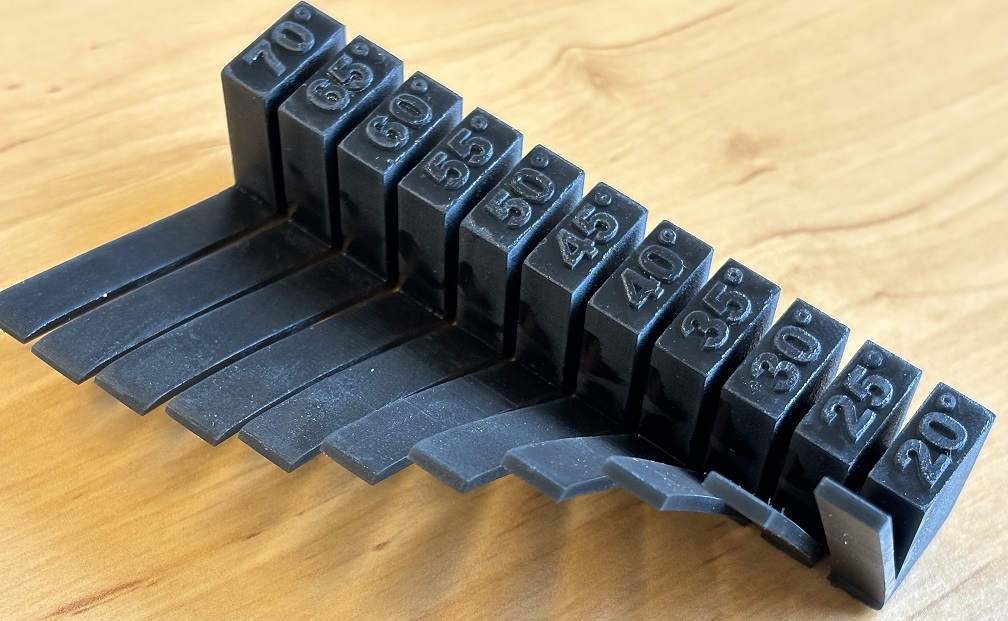
Image: Testing printing angle with the Thingiverse (Thing 40382) file and a small modification of it with thinner walls (2.0 mm)
For 2mm thick parts you can see a deformation in parts from an angle of 40°. Therefore it is advised to support parts from 35° and higher.
9) Part surface finish or sticky surface.
Printed parts from Liqcreate Tough-X are opaque and shiny during printing. A semi-matte surface will appear after washing and drying. Parts can be polished or coated to get a glossy surface finish.
10) Swelling of (green) printed parts during washing
Tough-X is sensitive for extended exposure to alcohol in its post-cured state but even more in the green state (not post-cured). Keep the time in washing solvents as short as possible (2 washes of 2 minutes is preferred) and keep the washing solvent below 30°C / 86°F. If the parts are not washed properly it is best to let them sit on your desk for an hour and wash again instead of washing it for an extended time at once.
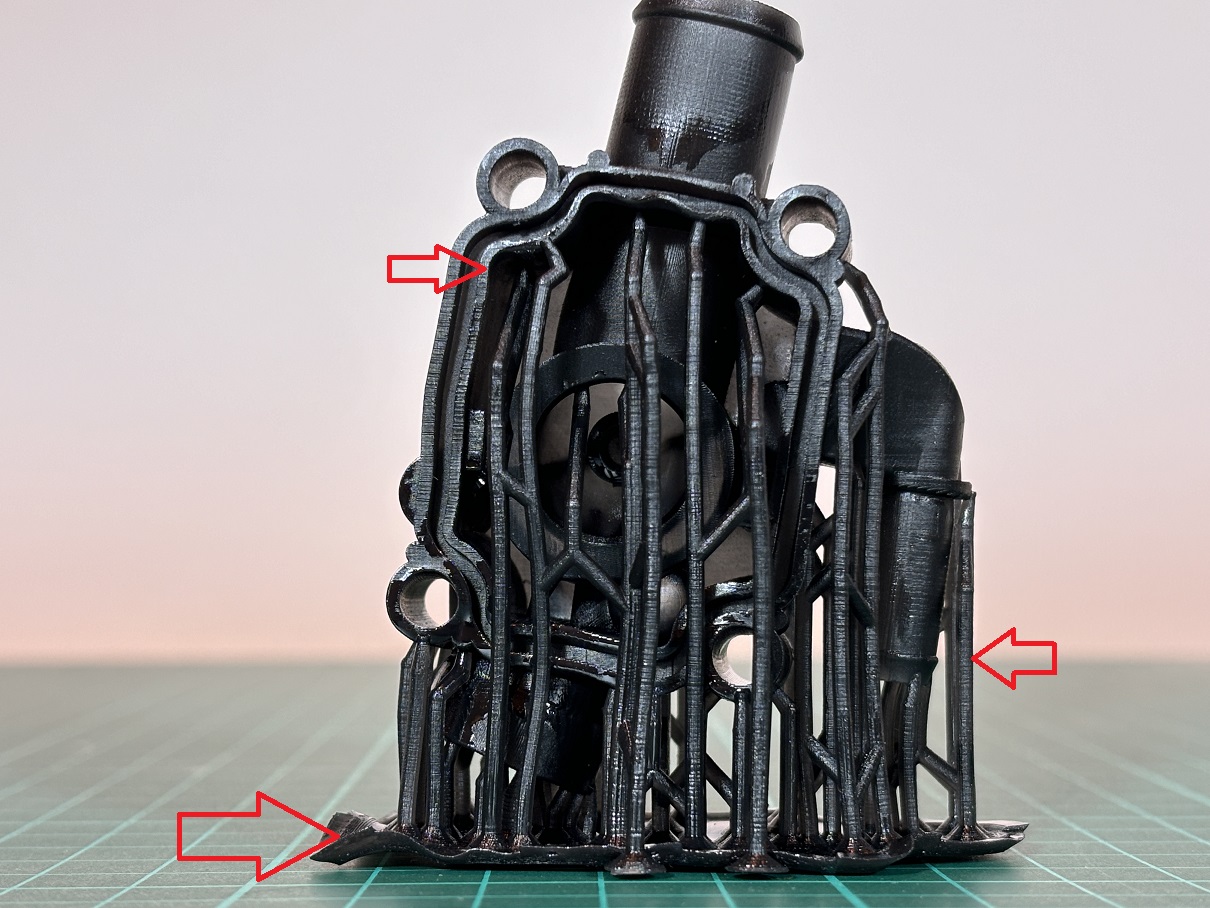
Parts can deform, this is most visible in the thin supports, thin baselayer or other thin areas in the part. With longer exposure to solvents the part itself can also swell slightly. For solvents like IPA or (bio)ethanol the parts do move back to the original size within a few hours. It is advised to wait 2 hours between washing and post-curing.
11) Shrinkage compensation.
Tested on the Anycubic Photon M3 Plus, the shrinkage compensation in Chitubox to get better accuracy can be found in the picture below. If you need super accurate parts, it is worth to read this article. As that article explains that the accuracy for thick and thin parts may deviate when the parameters are not correctly set.
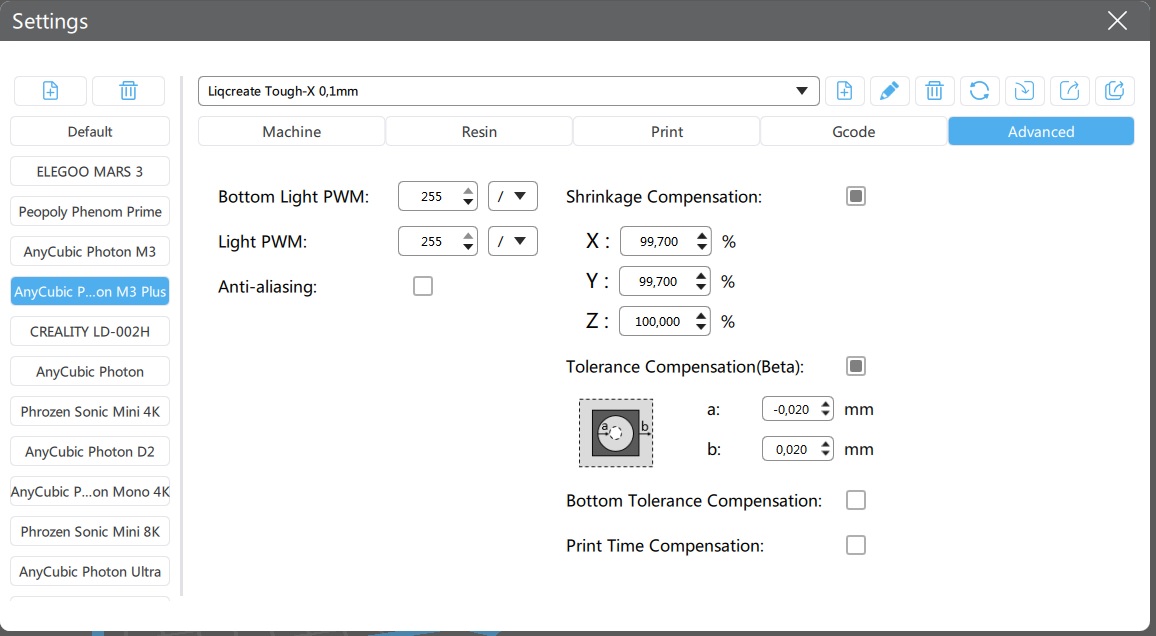 Image: Shrinkage / tolerance compensation for Tough-X in Chitubox tested on the Anycubic Photon M3 Plus.
Image: Shrinkage / tolerance compensation for Tough-X in Chitubox tested on the Anycubic Photon M3 Plus.
12) Resin printing temperature.
It is advised to print with Liqcreate Tough-X resin at least at 20°C / 68°F and maximum at 25°C / 77°F. printing at lower temperature causes random failure in the material.
13) Solving print failures with Liqcreate Tough-X resin.
There are a lot of common resin 3D-printing issues. In this article you can find 10 common resin 3D-printing fails and how to solve them. If you have need support, send is an e-mail at info@liqcreate.com and our technical team will try to assist.
14) Storage conditions.
Store the product in its original bottle, plug and cap at minimal 5°C / 41°F and maximum 30°C / 86°F. Avoid sources of heat, radiation, static electricity, sunlight and contact with food.
15) Additional documentation
- – Liqcreate Tough-X product page
- – Chemical compatibility of Liqcreate Tough-X
- – Technical Datasheet Liqcreate Tough-X
- – 3D-printing parameters of Liqcreate Tough-X
If you have any questions when working with Liqcreate Tough-X resin, send us an e-mail at info@liqcreate.com.
Tough-X
Liqcreate Tough-X is an opaque black photopolymer. 3D-printed parts from this material have exceptional durability. Liqcreate Tough-X is easy to on open DLP, MSLA and SLA 3D-printers in the range of 385 – 420nm. This material has excellent properties like high impact strength and up to 150% elongation, making it perfect for the production of industrial spare parts and functional tough and hard-rubber replacement products.
Key benefits |
3D-Printer compatibility |
| · Exceptional Impact Strength | · Epax3D Series |
| · High Elongation | · Phrozen3 Series |
| · Rigid rubber properties | · Elegoo & Anycubic Series |
| · Heavy Duty | · And many more |
